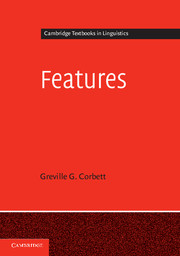Book contents
- Frontmatter
- Contents
- Figures
- Tables
- Preface
- Abbreviations
- 1 Why features?
- 2 Formal perspectives
- 3 Features for different components
- 4 Justifying particular features and their values
- 5 Typology
- 6 Canonical Typology and features
- 7 Determining feature values
- 8 Feature-value mismatches
- 9 Conclusions
- Appendix Standards and implementations
- References
- Author index
- Language index
- Subject index
Preface
Published online by Cambridge University Press: 05 November 2012
- Frontmatter
- Contents
- Figures
- Tables
- Preface
- Abbreviations
- 1 Why features?
- 2 Formal perspectives
- 3 Features for different components
- 4 Justifying particular features and their values
- 5 Typology
- 6 Canonical Typology and features
- 7 Determining feature values
- 8 Feature-value mismatches
- 9 Conclusions
- Appendix Standards and implementations
- References
- Author index
- Language index
- Subject index
Summary
Understanding the complexity of natural language is one of the great intellectual challenges. As linguists we try to do this through a variety of approaches and theories. For all our differences, one thing that most linguists share is the use of features. Features allow us to identify common properties; we propose a feature number, with the values singular and plural, as we find in forms like lake ~ lakes, loaf ~ loaves, woman ~ women. Using a feature like this captures the intuition that lake and lakes are forms of the same word, while on the other hand the plurals (lakes, loaves and women) are also in some sense the same. Though plural number is realized differently on each, they behave identically for agreement, since they all take a plural determiner (these rather than this). Other examples of features include gender (with values such as masculine, feminine…) and person (first, second, third). These are examples of morphosyntactic features. Features may also be semantic, such as animacy (ranging over human, other animate, inanimate), syntactic (for part of speech categories such as verb or noun), morphological (for inflectional class) or phonological (specifying, for instance, the height or backness of a vowel).
Features, then, are our means of capturing what is consistent across linguistic entities within a language; they also help us to identify what is consistent across languages. Various languages have a number feature rather similar to that of English, while in others this feature shows interesting differences. Features have proved invaluable for analysis and description, and they have a major role in contemporary linguistics, from the most abstract theorizing to the most applied computational work. As we rely increasingly on features, it is important to review our assumptions and check our progress in understanding them. In particular, there is a tradition in a part of the discipline to be careful about the formal properties of features, being scrupulous about the mechanisms according to which they work within given theories. Another set of linguists have worked hard to understand the substantive semantics of features, to establish what features and values there can be, and what they mean. Sometimes the first group, those working on the formal side of features, have not realized the richness of the data offered by natural languages. Conversely, those in the second group, the typologists, have not always been sufficiently concerned about the formal consequences of the patterns they have identified.
- Type
- Chapter
- Information
- Features , pp. xiii - xvPublisher: Cambridge University PressPrint publication year: 2012



